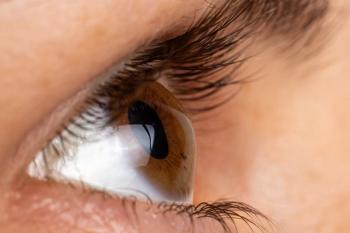
7 pearls to guide glaucoma treatment
In an effort to take the best care of my glaucoma patients that I can, I’ve made use of a few pearls that have helped me to keep calm in the face of the beast that is glaucoma.
We often hear about “structure vs. function” as pertains to glaucoma. We also hear that structural damage (as evidenced by direct viewing and complementary imaging studies like OCT, GDx, or HRT) should correspond (somewhat) with functional damage (as evidenced by visual field studies).1 We go to weekend lectures and see nice and tidy cases of inferior neuroretinal rim notches with corresponding superior nasal step defects. We sit back and say, “Yeah, that makes sense, and that’s exactly how I would treat that patient.”
Making the call
I’ll speak for myself here. I get back to my office on Monday and sit down before a slew of glaucoma suspects who are either not able to undergo reliable visual field studies, have cataracts or other confounding variables affecting my evaluation of their optic nerves and visual fields, can’t lean over to get in front of the OCT, are poor historians, don’t know their current medications, or any combination or permutation thereof. Then, I’m sometimes left with diagnostic information that makes, at best, very little sense. I’m not saying structure and function don’t always agree. I’m just saying that my testing of them doesn’t always agree.
Now, I love my patients (well, the ones who don’t think I’m 12 years old), and I like having answers for them when they ask me if they have glaucoma. However, often I just don’t know right off the bat if a patient truly has glaucoma or not (and, if glaucoma is present, whether or not I need to do anything about it). In its early stages (or sometimes later stages), glaucoma can be a tough diagnosis to make. It’s also a tough diagnosis to take away once made. In an effort to take the best care of my glaucoma patients that I can, I’ve made use of a few pearls that have helped me to keep calm in the face of the beast that is glaucoma.
1. Keep it as simple as you can.
Making a case for or against a diagnosis of glaucoma can be and is complicated, but a fundamental approach can help. I always start with stereoscopic optic nerve evaluation to help me to go through my mental flowchart of glaucoma care.
2. Look at the optic nerves without thinking about the IOPs.
I know. I can’t do it either, but I think it hammers home a good point that we label people glaucoma suspects because of their optic nerves and not based solely on IOPs. (That’s why the ICD 9 code 365.04-ocular hypertension-exists separately.) To take it a step further, I don’t have a magic IOP value that says “treat no matter what.” I generally treat because I see optic nerve damage.
3. Patients can have as many diseases as they pleases.
Full disclosure: I unabashedly stole this phrase from Dr. Mitch Dul and Dr. Patricia Modica. I don’t know if they invented it, but I wish I had. Diseases such as systemic hypertension, systemic hypotension, migraine headaches, etc., can affect, at least transiently, blood flow to the optic nerve. While there may not be a causal relationship of one’s systemic disease to one’s glaucoma, it’s good measure to keep in mind the fact that there can be non-IOP factors present with any patient.
4. Glaucoma is only one optic neuropathy.
There is a lot that can happen to a ganglion cell on its way to its first synapse, which doesn’t occur until it gets all the way to the lateral geniculate nucleus in the midbrain-that’s like a thousand miles for you and me. Many optic neuropathies may not be progressive at all. Yes, I know this directly contradicts the first pearl.
5. Repeat the visual field study.
If there’s one thing to remember from this article, please let it be that reliable and repeatable visual field studies are of paramount importance when determining the presence and rate of progression. Serial visual fields and OCTs (a few in the first year or so) can be a great way to get a feel for how a patient is going to behave in the future. Getting paid for that is a whole other subject.
6. You’ve got time on your side.
Establishing a diagnosis of glaucoma and deciding how to proceed can take some time, but that’s OK. Glaucoma is typically a slow disease, and it should take some time to establish a diagnosis and even more time to establish rate of progression. Multiple visual field and imaging studies take time, and it’s a lot to sort through. However, you’ve got time to collect data and make some sense of it.
7. It’s OK to say “I don’t know”
I don’t recommend saying that exact phrase to patients. But patients do want answers. If a patient asks me, “Do I have glaucoma?” and I’m not sure yet, I’m simply honest about it. I may say something such as, “I’m suspicious about glaucoma, and that’s why we’ve done these baseline tests. However, based on the results, I can’t say flat out that you have glaucoma. If I were you, I would want to repeat these tests again in a few months. If the results change, we should probably start treatment. If they stay like they are today, I promise I’ll leave you alone for a little while.”
Taking a second look
I hope these pearls can provide some guidance in the face of glaucoma. It’s easy to get flustered and feel rushed, but establishing a fundamental approach beginning with direct optic nerve evaluation helps me to stay calm and perform my due diligence before jumping the gun when deciding to treat or to monitor.
In my young naiveté, I tried to make some sense out of this FDT visual field study. Simply bringing the patient back in to repeat the study yielded an inferior nasal defect that I was more “comfortable” with (see Figures 1 and 2).ODT
Reference
1. De Moraes et al. Understanding disparities among diagnostic technologies in glaucoma. Arch. Ophthalmol. 2012 July;130(7):833-40.
Newsletter
Want more insights like this? Subscribe to Optometry Times and get clinical pearls and practice tips delivered straight to your inbox.













































